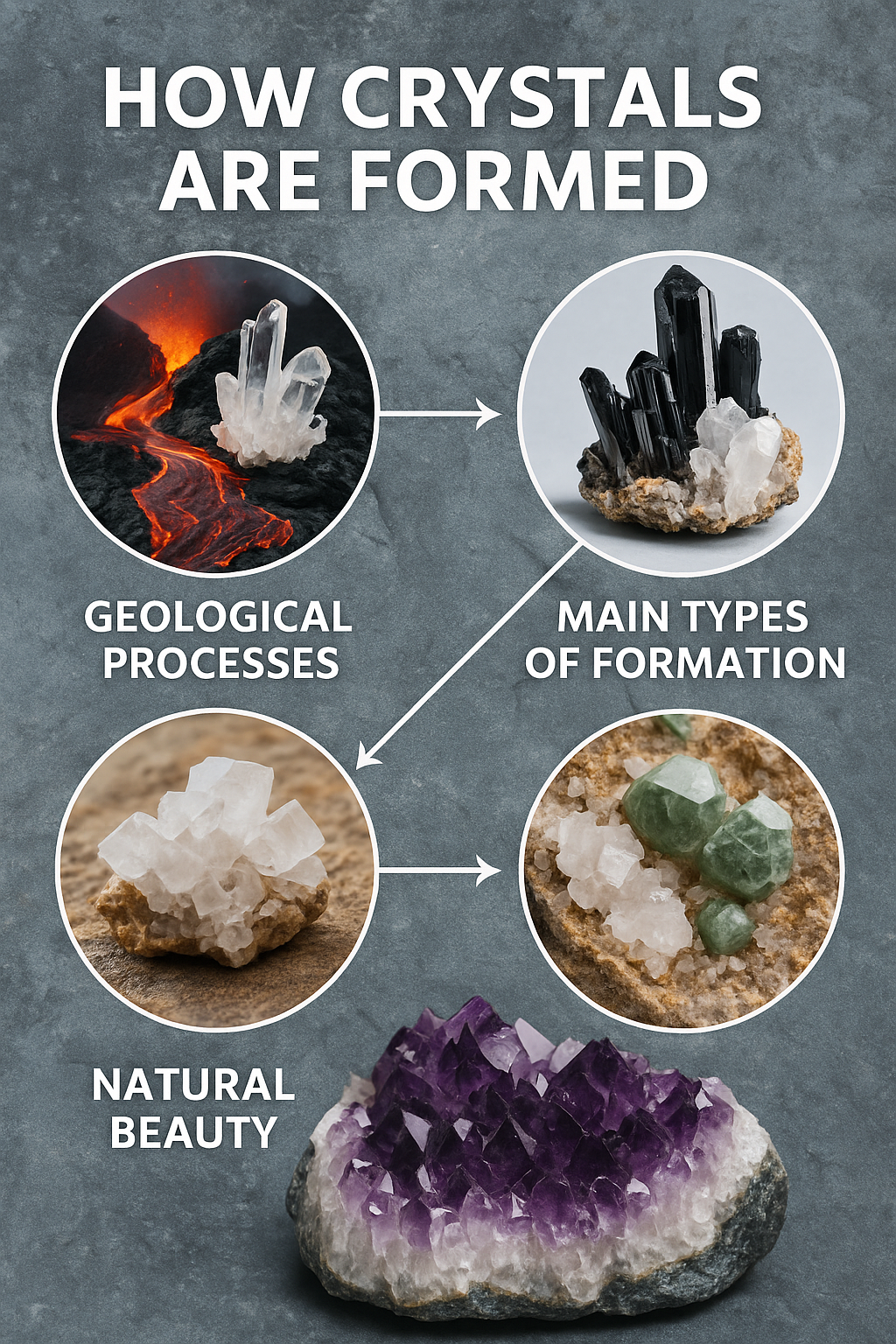
How Crystals Are Formed: Nature’s Masterpieces
Share
1. Introduction
Crystals are among the most captivating natural formations on Earth. They are solids whose atoms are arranged in a highly ordered, repeating pattern, and each one tells a story of geological history that can span millions of years. From the glittering amethyst geodes of Brazil to the pure clarity of Himalayan quartz, each crystal is shaped by specific geological conditions.
2. The Science Behind Crystal Formation
-
Atomic Structure
A crystal’s shape and structure are defined by how its atoms bond and arrange themselves in a repeating geometric pattern. This arrangement is determined by the chemical composition of the mineral and the environment in which it grows. -
Crystallization Process
Crystals form when a mineral transitions from a fluid (liquid or gas) or dissolved state into a solid, under conditions that allow atoms to organize into a crystal lattice.
3. Main Types of Crystal Formation
-
Magmatic (Igneous) Crystallization
- Occurs when magma or lava cools and solidifies. Slow cooling deep underground allows larger, well-formed crystals to grow (e.g., quartz, amethyst, feldspar). Rapid cooling on the surface produces smaller crystals.
-
Example: The large quartz crystals from Minas Gerais, Brazil, formed in slow-cooling pockets of molten rock.
-
Sedimentary Evaporation
- In arid environments, water rich in dissolved minerals evaporates, leaving behind crystalline deposits. Common in salt flats and caves.
-
Example: Halite (rock salt) and gypsum in the deserts of Utah.
-
Metamorphic Processes
- Existing minerals are transformed under intense heat and pressure within the Earth’s crust, forming new crystalline structures without melting.
-
Example: Garnet crystals forming in metamorphosed shale.
-
Hydrothermal Growth
- Hot, mineral-rich water circulates through cracks in rocks, depositing minerals as it cools. This process can create highly transparent and vibrant crystals.
-
Example: Tourmaline, aquamarine, and topaz from pegmatite veins.
5. Timeframe of Crystal Growth
- Some crystals, like halite, can form in weeks or months under the right conditions.
- Others, such as large quartz clusters or diamond deposits, take millions of years to develop.
- Growth speed depends on factors such as temperature stability, mineral availability, and space for crystals to expand.
6. Factors Influencing Crystal Quality
- Purity of the Environment: Fewer impurities result in clearer, more valuable crystals.
- Growth Rate: Slow growth often produces larger, well-defined crystals.
- Space Availability: Limited space may cause crystals to grow in clusters or interlock with others.
- Pressure & Temperature Stability: Fluctuations can cause inclusions, fractures, or unique patterns.
7. Why Every Crystal is Unique
Each crystal is shaped by a unique combination of geological, chemical, and environmental factors. Variations in mineral content, trace elements, and growth conditions lead to different colors, patterns, and inclusions. This is why no two crystals are exactly alike.
8. Famous Crystal Formation Sites
- Brazil – Known for giant amethyst geodes and clear quartz clusters.
- Himalayas – Produces high-energy, clear quartz crystals formed under extreme pressure.
- Madagascar – Renowned for rose quartz and labradorite deposits.
- Arkansas, USA – Famous for exceptionally clear quartz points.
9. Conclusion
Crystals are living records of Earth’s geological artistry. Each one holds a fragment of the planet’s deep-time history, formed through processes that balance chemistry, temperature, and pressure over unimaginable timescales.
水晶形成的奧秘:地質過程與大自然的藝術
1. 前言
水晶是地球最迷人的天然礦物之一。它們由原子以高度有序、重複的方式排列而成,每一顆水晶都承載著數百萬年的地質故事。從巴西的巨大紫水晶晶洞到喜馬拉雅的透明白水晶,每一顆都在特定的地質條件下孕育而成。
2. 水晶形成的科學原理
-
原子結構
水晶的形狀與結構取決於原子的化學鍵合方式和排列規律,這由礦物成分與生長環境共同決定。 -
結晶過程
當礦物從液態、氣態或溶解狀態轉變為固態,並在適當條件下讓原子有序排列,就形成了晶格結構的晶體。
3. 水晶形成的主要類型
-
岩漿結晶(火成岩成因)
- 當岩漿或熔岩冷卻並凝固時,礦物逐漸結晶。地底緩慢冷卻能形成較大且形態完整的晶體,如石英、紫水晶、長石;地表快速冷卻則形成較小的晶體。
-
例子:巴西米納斯吉拉斯州的巨型石英晶簇。
-
沉積蒸發作用
- 在乾旱環境中,富含礦物的水分蒸發後留下晶體沉積,如鹽湖與洞穴沉積物。
-
例子:美國猶他州的岩鹽與透石膏。
-
變質作用
- 原有礦物在地殼高溫高壓下轉變為新的晶體結構,而不經過熔融。
- 例子:片岩中生成的石榴石。
-
熱液作用
-
- 高溫富含礦物的熱水流經岩石裂縫,冷卻後沉積形成晶體。
- 例子:海藍寶、碧璽、黃玉在偉晶岩脈中生成。
5. 生長所需時間
- 鹽類礦物(如岩鹽)可能在數週至數月內生成。
- 大型石英晶簇或鑽石礦床則需要數百萬年才能形成。
- 影響生長速度的因素包括溫度穩定性、礦物供應量與晶體生長空間。
6. 影響水晶品質的因素
- 環境純淨度:雜質少的晶體通常更透明且價值更高。
- 生長速度:緩慢生成的晶體往往更大且結構完整。
- 空間條件:有限空間會導致晶體群聚生長或互相嵌合。
- 壓力與溫度穩定性:波動可能造成內含物、裂痕或特殊花紋。
7. 為什麼每顆水晶都是獨一無二
不同的礦物成分、微量元素與生長條件造就了水晶的顏色、紋理與內含物差異,因此世界上沒有兩顆完全相同的水晶。
8. 世界著名水晶產地
- 巴西 – 巨型紫水晶晶洞與透明石英晶簇。
- 喜馬拉雅山 – 高能量透明白水晶,在極端壓力下形成。
- 馬達加斯加 – 玫瑰石英與拉長石礦床聞名。
- 美國阿肯色州 – 以產出極為透明的石英尖晶著稱。
9. 結語
水晶是地球地質藝術的活檔案,每一顆都是化學、溫度與壓力平衡下孕育的奇蹟。擁有一顆水晶,就像握住了地球數百萬年的歷史。
